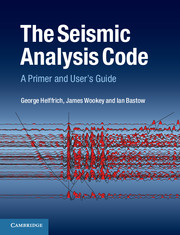Book contents
- Frontmatter
- Contents
- Preface
- Acknowledgements
- 1 Introduction
- 2 The SAC data format
- 3 The SAC processing philosophy
- 4 Basic SAC commands
- 5 SAC macros
- 6 Accessing SAC functionality and data from external programs
- 7 Graphical data annotation
- 8 Array data handling
- 9 Spectral estimation in SAC
- 10 Three-dimensional data in SAC
- 11 Implementation of common processing methodologies using SAC
- Appendix A Alphabetical list of SAC commands
- Appendix B Keyword in context for SAC command descriptions
- References
- Index
- Plate Section
4 - Basic SAC commands
Published online by Cambridge University Press: 05 October 2013
- Frontmatter
- Contents
- Preface
- Acknowledgements
- 1 Introduction
- 2 The SAC data format
- 3 The SAC processing philosophy
- 4 Basic SAC commands
- 5 SAC macros
- 6 Accessing SAC functionality and data from external programs
- 7 Graphical data annotation
- 8 Array data handling
- 9 Spectral estimation in SAC
- 10 Three-dimensional data in SAC
- 11 Implementation of common processing methodologies using SAC
- Appendix A Alphabetical list of SAC commands
- Appendix B Keyword in context for SAC command descriptions
- References
- Index
- Plate Section
Summary
COMMAND STYLE
SAC commands are typed from the command line or read from a file. After each command is processed, SAC reads another command from its input source until it is told to stop or the input is exhausted.
Commands are single verbs (e.g., READ, WRITE), or a compound phrase (e.g., FILTER-DESIGN). Abbreviations exist for the longer or commonly used command names. A series of options that control the command's actions follow the command name. Command names or options may be typed in upper or lower case. However, when file names appear in commands, case does matter, and SAC preserves it.
White space separates options and the command name, and can even precede the command name. This is useful for indenting groups of commands for documentation purposes.
Multiple commands may be placed on the same line separated by the “;” (semicolon) character and will be processed left-to-right as they appear on the command line. Any command whose first character is * is a comment and is ignored. Thus the string ; * introduces a comment in the command listings that follow.
SAC supplies default command options if they are not specified. Command options, once set, stay in force for future uses of the same command. This provides a way to tailor personal command defaults. SAC can read a file of commands setting your personal defaults before it reads the input. They will be described in detail in Section 4.10.
- Type
- Chapter
- Information
- The Seismic Analysis CodeA Primer and User's Guide, pp. 17 - 37Publisher: Cambridge University PressPrint publication year: 2013



